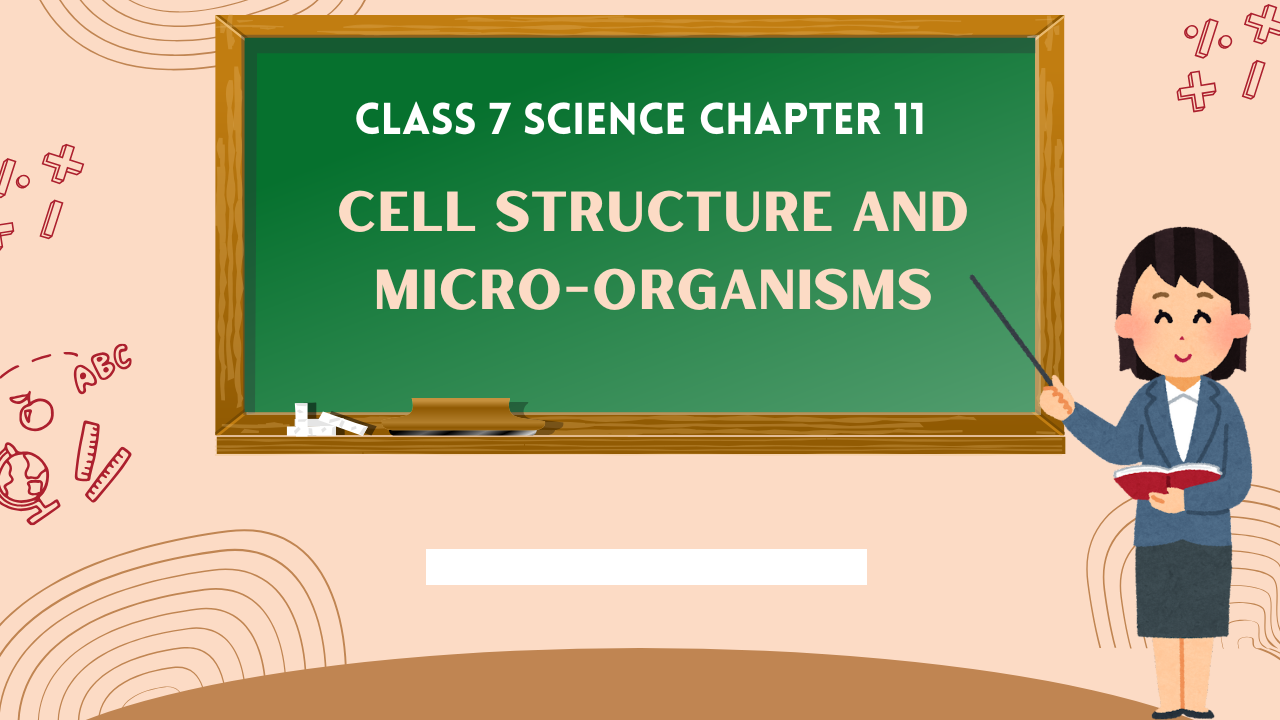Balbharti Maharashtra State Board Class 7 Science Solutions Chapter 11 Cell Structure and Micro-organisms Notes, Textbook Exercise Important Questions and Answers.
Std 7 Science Chapter 11 Cell Structure and Micro-organisms Question Answer Maharashtra Board
Class 7 Science Chapter 11 Cell Structure and Micro-organisms Question Answer Maharashtra Board
1. Answer the following questions.
Question a.
What is a cell?
Answer:
The cell is the fundamental, structural and functional unit of living organism.
Question b.
Name the different organelles in a cell.
Answer:
The nucleus, endoplasmic reticulum, Golgi bodies, lysosomes, mitochondria, vacuoles, plastids, chloroplasts are the different organelles in a cell.

Question c.
What are micro-organisms?
Answer:
The organisms which cannot be seen with our eyes but can only be observed under a microscope are called micro-organisms.
Question d.
Which are the different types of micro-organisms?
Answer:
Algae, fungi, bacteria, protozoa and viruses are various types of micro-organism. Some are unicellular and others are multicellular. Some of them are useful and some are harmful.
2. Fill in the blanks with the proper word.
Question a.
The organelle called the ……………. is present in the plant cells only.
Answer:
chloroplasts
Question b.
Garbage is converted into ……….. by microorganisms.
Answer:
fertilizer

Question c.
In the cell, photosynthesis is carried out with the help of …………… .
Answer:
chloroplast
Question d.
An electron microscope is necessary for the study of ……………… .
Answer:
micro-organism
Question e.
The process of preparing their own food in presence of sunlight and chloroplast by plants cells is known as ……….. .
Answer:
photosynthesis.
3. What is the difference between us?
Question a.
Plant cell and animal cell.
Answer:
| Plant cell | Animal cell |
| 1. Plant cell has cell wall. | 1. Cell wall is absent in animal cell. |
| 2. Plant cell has definite shape due to presence of cell wall. | 2. Animal cell do not have definite shape. |
| 3. Plant cell has one big vacuole. | 3. Animal cells have many small vacuoles. |
| 4. Plant cell has chloroplast so they produce their own food. | 4. Animal cells do not have chloroplast, so they cannot produce their own food. |
| 5. Plant cell has plastids. | 5. Plastids are absent in animal cell. |
| 6. Centrosomes are absent in plant cell. | 6. Centrosomes are present near the nucleus. |
| 7. Lysosomes are absent in plant cell. | 7. Lysosomes are present in animal cell. |

Question b.
Prokaryotic cell and Eukaryotic cell
Answer:
| Prokaryotic cell | Eukaryotic cell |
| 1. No well defined nucleus. | 1. Well defined nucleus with a nuclear membrane |
| 2. Ribosomes are small. | 2. Ribosomes are large. |
| 3. A single length of DNA is present. | 3. Several lengths of genetic materials (DNA) is present. |
| 4. No other cell organelles are present. | 4. Several organelles like mitochondria, chloroplasts, etc. are present. |
| 5. Examples: Bacteria, blue green algae | 5. Examples: Euglena, Amoeba, all plant and animal cells |

4. Sketch and describe in your on words, the plant cell and animal cell.
Question a.
Sketch and describe ¡n your on words, the plant cell and animal cell.
Answer:
There are two types of cell-animal cells and plant cells. These cells contain various types of membrane beyond cell-organelles. Plant cells have a definite shape due to the presence of cell wall. Besides, unlike animal cells, plant cells contain single large vacuole. All these cells are known as eukaryotic cells. It cell has four main parts: the cell wall, cell membrane, cytoplasm and cell organelles.
1. Cell wall: The cell wall is the outermost covering of a cell. It is present only in plant cells.
2. Plasma membrane: The plasma membrane, also called the cell membrane, is a kind of thin covering, (a) It is extremely delicate and flexible, (b) It is the outermost covering of animal cells.
3. Cytoplasm: The liquid part in the cell, present around the nucleus is called cytoplasm, (a) It occupies the space between the plasma membrane and nucleus, (b) Cell organelles are scattered in the cytoplasm.
4. Cell organelles: These mainly include the nucleus, endoplasmic reticulum, Golgi bodies, lysosomes, mitochondria, vacuoles, plastids etc.
Plant cells contain chloroplasts.
(a) The nucleus is the most important organelle of the cell, (b) There is a porous double membrane around it. (c) The nucleus controls all functions of the cell, (d) The endoplasmic reticulum is a sprawling net-like organelle. Its function is to make necessary changes in the proteins produced by ribosomes and send them to the Golgi bodies, (e) Golgi bodies are made up of several flat sacs. Their function is the proper distribution of proteins.
(f) Mitochondria and plastids are organelles with double outer coverings, (g) As mitochondria produce energy, they are called the powerhouses of the cell, (h) The chloroplasts in plant cells carry out the function of photosynthesis, (i) Vacuoles help to throw out waste products of the cell, (j) Vacuoles in animal cells are small whereas there is only one large vacuole in a plant cell.

5. Explain the uses and the harmful effects of micro-organisms.
Question a.
Explain the uses and the harmful effects of, micro-organisms.
Answer:
Micro-organisms which are helpful are called useful micro-organisms.
Uses:
1. Micro-organisms present in nodules of leguminous plants, convert atmospheric nitrogen into its compounds and these compounds help to increase the soil fertility and protein content in the soil.
2. Some micro-organisms are useful in process of fermentation, making the food easily digestible and more nutritious. For producing milk products like butter, buttermilk, cheese, paneer, etc.
3. Microbes present in soil, dung etc. decompose garbage and convert into manure of best quality and surrounding is kept clean.
4. Microbes are also useful for sewage disposal. They help in decomposition of organic compounds in it.
5. Microbes are used in production of vaccines.
6. Microbes are also used in processes like tanning of skin, production of ropes and strings, from agave.
7. Some microbes use oil for their growth. Such microbes are used to clear a layer of oil floating on the surface of an ocean or lake formed due to leak or spill.
8. Farm waste, human urine and faeces, wet garbage etc. is collected and used in a biogas plant to produce biogas and fertilizer.
Harmful effects:
1. Disease producing micro-organisms are called pathogens, they are harmful micro-organisms.
2. Fungus grows on moist food, and microbes release enterotoxins into the food. Such toxins spoil the foods. Eating such spoiled food causes food poisoning i.e. loose motions and vomiting.
3. Pathogens may be present in water bodies contaminated with sewage, and dirt from surroundings, in food with flies sitting on it. If such contaminated food or water is consumed, we may fall ill with diseases like amoebiasis, typhoid, cholera, hepatitis, gastro, etc.
4. Pathogens are released in the air by a person having infection of the respiratory, sneezes or coughs. A healthy person may get infected by pathogens on breathing in the same air and contract diseases like common cold, cough, diphtheria, pneumonia, tuberculosis, etc.
5. Microbes that cause diseases like malaria, dengue, elephantiasis, yellow fever, chikunguniya, zike
fever etc. gain entry into the human body through the bite of a female mosquito.

6. Give reasons.
Question a.
Diseases spread on a large scale during periods of heavy rainfall and floods.
Answer:
- Due to floods there is shortage of clean, safe drinking water.
- It gets contaminated with sewage and dirt having disease causing pathogens, causing disease of alimentary canal, typhoid, cholera, dysentery.
- Due to stagnant water, many mosquitoes breed on it and cause diseases like malaria, dengue, etc.
Question b.
There is a possibility of food poisoning if we eat stale food.
Answer:
- Fungus grows quickly on moist and stale food. Micro-organisms grown on the food release toxic materials like enterotoxin into the food.
- Such toxins spoil the food.
- Eating such spoiled food may cause loose motions and vomiting. So, we should eat food which is freshly prepared.
Question c.
Soil is turned over during tilling.
Answer:
- Tilling is done to loosen the soil in initial agricultural practice.
- Loose soil allows the penetration of roots of the plant.
- By turning of soil, it allows uniform mixing of manure and fertilizer.
- It increases the fertility of soil. Seeds also germinate easily in aerated soil. Hence, soil is turned during tilling.

Question d.
Fungus grows quickly in moist or humid condition.
Answer:
- Fungus needs water and moisture for its growth.
- Humidity brings about spore germination and the fungus is able to grow and reproduce quickly in moist or humid condition.
Question e.
A refrigerator is used in almost every home.
Answer:
- Refrigerator is used to keep food item in healthy condition and to keep them fresh.
- If the food items are kept outside, they spoil very fast due to growth of micro-organisms and they make food spoiled and harmful.
- The optimum temperature for the growth of micro-organism is 15°C to 35°C.
- In refrigerator the temperature is kept very low. So, the food is preserved in refrigerator.
Question f.
Bread rises during baking.
Answer:
- The process of fermentation is used in baking, for example, in making bread. Yeast is added to make the dough rise.
- The fermentation is a chemical process of conversion of one type of carbon compound into another type of carbon compound by the action of micro-organisms.
- Heat is generated in this process. Carbon dioxide (CO 2 ) and some other gases are released.
- These gases cause an increase in volume so the bread dough rises.

Question g.
Fodder is soaked in water before offering to cattle.
Answer:
- In dry fodder only some part of it is useful for cattle and rest is wasted.
- When fodder is soaked in water, it sprouts.
- So, to make the fodder more nutritious and more easy to digest it is soaked in water before offering to cattle.
7. When will you use a simple microscope and when a compound microscope?
Question a.
When will you use a simple microscope and when a compound microscope?
Answer:
- I will use a simple microscope to magnify the objects and to see the growth of a fungi or mucor on a piece of moist bread.
- I will use a compound microscope in Research Laboratory and high school science lab to observe micro-organisms which we are not able to see with our naked eye.

Project :
Question 1.
Visit a bakery in your area, collect information about the process of manufacture of their products and make one of them at home.
Class 7 Science Chapter 11 Cell Structure and Micro-organisms Important Questions and Answers
Fill in the blanks and rewrite the sentences:
Question 1.
………… is the fundamental, structural and functional unit of living organism.
Answer:
Cell
Question 2.
The four main parts of the plant cell are …………, …………, ………… and ………… .
Answer:
cell wall, cell membrane, cytoplasm, cell organelle
Question 3.
Plant cell contains ………… which carry out the process of photosynthesis.
Answer:
chloroplast

Question 4.
…………… are called the power houses of the cell.
Answer:
Mitochondria
Question 5.
The outermost covering of plant cell is …………. .
Answer:
cell wall
Question 6.
The outermost covering of animal cell is ………….
Answer:
plasma membrane
Question 7.
The ………… is the most important organelle of the cell.
Answer:
nucleus
Question 8.
………… is a national movement started several years ago to increase awareness about public hygiene and personal hygiene.
Answer:
Swach Bharat Abhiyan

Question 9.
The body temperature of a healthy human being is about ………… .
Answer:
37°C
Question 10.
Micro-organisms use food stuffs for their own nutrition and release toxic materials called ………. .
Answer:
enterotoxins
Name the following:
Question 1.
An instrument used to observe cells.
Answer:
Microscope
Question 2.
I control the function of a cell.
Answer:
Nucleus

Question 3.
I am like a policeman. I do not allow anything and everything to get in and out of the cell.
Answer:
Cell membrane
Question 4.
Outermost layer of the plant cell.
Answer:
Cell wall
Question 5.
Outermost layer of the animal cell.
Answer:
Cell membrane
Question 6.
I am the jelly like substance containing all the organelles.
Answer:
Cytoplasm

Question 7.
I contain thread like structures called chromosome.
Answer:
Nucleus
Question 8.
Which part of the cell contain organelles.
Answer:
Cytoplasm
Question 9.
The unit of measurement used for expressing dimension, size of the cell.
Answer:
Nanometer, micrometer
Question 10.
The power house of the cell.
Answer:
Mitochondria
Question 11.
Largest organelle in the plant cell.
Answer:
Vacuole
Question 12.
It is necessary for photosynthesis.
Answer:
Chlorophyll

Question 13.
The living substance in the cell.
Answer:
Cytoplasm
Question 14.
A group of cells.
Answer:
Tissue
Question 15.
Empty structures in cytoplasm.
Answer:
Vacuole
State whether the following statements are True or False. Correct and rewrite the false statement:
Question 1.
Cells can be easily seen with naked eyes.
Answer:
False. We can’t see cells with naked eyes, can be seen under microscope

Question 2.
A single cell can perform all the functions in a unicellular organism.
Answer:
True
Question 3.
Cell wall is present in both plant cells and animal cells.
Answer:
False. Cell wall is present only in plant cell
Question 4.
Vacuoles are not found in plant cell.
Answer:
False. Large vacuole is found in plant cell
Question 5.
Tissue is a group of dissimilar cells.
Answer:
False. Tissue is a group of similar cells.

Question 6.
Unicellular organisms have one celled body.
Answer:
True.
Question 7.
The basic living unit of an organism is an organ.
Answer:
False. The basic living unit of an organism is the cell.
Question 8.
The unit of measurement used for expressing dimension size of the cell is centimetre.
Answer:
False. It is nanometer.
Question 9.
Micro-organism cannot grow in extreme adverse conditions.
Answer:
False. Some micro-organisms can survive in extreme adverse conditions e.g. ocean floor, ice polar region, hot water spring.

Question 10.
Some micro-organisms can grow without oxygen.
Answer:
True
Question 11.
Amoeba has irregular shape.
Answer:
True
Question 12.
The process of fermentation is used for making yogurt from milk.
Answer:
True
Question 13.
Micro-organisms need an optimum temperature of 55°C to 70°C to grow.
Answer:
False. They need temperatures between 15°C to 35°C to grow well.
Question 14.
Cells with membrane bound organelles inside them are called prokaryotic cells.
Answer:
False. Cells with membrane bound organelles inside them are called eukaryotic cells.

Question 15.
Golgi bodies are the power houses of the cells.
Answer:
False. Mitochondria are the power houses of the cell.
Choose the correct word.
Question 1.
Which one of the following terms is not a part of the nucleus?
(a) ribosome
(b) DNA
(c) chromosome
(d) gene
Answer:
(a) ribosome
Question 2.
A suitable term for the various components of cell is.
(a) tissue
(b) cell organelle
(c) chromosome
(d) gene
Answer:
(b) cell organelle

Question 3.
The jelly like fluid substance present in the cells is called.
(a) protoplasm
(b) chromosome
(c) chloroplast
(d) cytoplasm
Answer:
(d) cytoplasm
Question 4.
The units of measurement used for expressing dimension size of the cell are,
(a) centimetre
(b) micrometre
(c) nanometre
(d) metre
Answer:
(c) nanometre, (b) micrometre.
Question 5.
The largest cell in the human body
(a) nerve
(b) muscle
(c) liver
(d) kidney
Answer:
(a) nerve
Question 6.
The barrier between protoplasm and other environment in animal cell
(a) plasma membrane
(b) cell wall
(c) nucleus membrane
Answer:
(a) plasma membrane

Question 7.
The term cell wall is given by
(a) Leeuwenhoek
(b) Robert Hooke
(c) Fleming
Answer:
(b) Robert Hooke
Question 8.
The cell theory was proposed by.
(a) Watsonar Cricks
(b) Schleiden
(c) Schwann
(d) Mengal Morgan
Answer:
(b) Schleiden, (c) Schwann.
Question 9.
Which of the following features will help you in distinguishing a plant cell from an animal cell.
(a) cell wall
(b) cell membrane
(c) mitochondria
(d) nucleus
Answer:
(a) cell wall
Question 10.
The gas released during the preparation of bread,
(a) O
2
(b) CO
2
(c) nitrogen
(d) sulphur oxide
Answer:
(b) CO
2

Question 11.
The structural-functional unit of life is called.
(a) cell
(b) tissue
(c) organ
(d) organism
Answer:
(a) cell
Question 12.
Which organelle is called power house of the cell?
(a) centrosome
(b) lysosome
(c) plastid
(d) mitochondria
Answer:
(d) mitochondria
Question 13.
Living substance of cell is called.
(а) cytoplasm
(b) protoplasm
(c) nucleus
(d) chromosome
Answer:
(а) cytoplasm
Give scientific reasons:
Question 1.
Mitochondria are called the power houses of the cell.
Answer:
- Mitochondria are tiny organelles inside the cells that are involved in releasing energy from food.
- This process is known as cellular respiration.
- It is for this reason that mitochondria are often referred to as the power houses of the cell.

Question 2.
A compound microscope is used for observing cells.
Answer:
- Cell are extremely minute in size.
- We cannot see cells with naked eye.
- An object when kept on a glass slide is magnified many times by the lenses of this microscope.
- Hence, compound microscope is used for observing cells.
Question 3.
Cells are the basic structural units of living organism.
Answer:
- Cells are the smallest unit from which a living organism is made.
- A cell contains all the necessary structures which are required to carry out various biological processes.
- A group of cells makes a tissue, which further makes an organ and many organs together make an organ system and finally organism. Thus, the cells are the basic structural units of living organism.
Answer the following in short:
Question 1.
What is a vaccine?
Answer:
Vaccine is a live micro-organism which is weak but in a very small amount, and is injected into a person so that antibodies are produced against that micro-organism.

Question 2.
What are the similarities between the Plant cell and Animal cell?
Answer:
They both have cell membrane, cytoplasm, nucleus, ribosomes, golgi bodies, mito-chondria, vacuoles and chromosomes.
Question 3.
What do micro-organisms need for growth?
Answer:
Micro-organisms need soil, water and decaying material. Temperature suitable for microbial growth is 15 to 35°C moist, humid and warm climate.
What is the difference between us:
Question 1.
Simple microscope and Compound microscope.
Answer:
| Simple microscope | Compound microscope |
| 1. It consists of single lens. | 1. It consists of 2 lenses. |
| 2. Magnification power is upto 300X | 2. Magnification power is upto 2000X. |
| 3. It uses natural light source. | 3. It uses illumination as light source. |
| 4. It is used to observe small objects. | 4. It is used to observe very tiny objects or cells which we cannot see with naked eye. |

Answer in details:
Question 1.
Explain the functions of organelles in a cell.
Answer:
1. Functions of cell wall: It consist of cellulose. It is present in plant cell only. It is a protective layer outside the cell membrane. It provides structural support and protection.
2. Function of cell membrane: It controls the movement of substances in and out of the cell. It protect the cell from its surrounding.
3. Function of cytoplasm: It is the jelly like liquid, it occupies space between cell membrane and nucleus. All the organelles are scattered in it.
4. Function of Nucleus: It is the brain of the cell. It directs all cell activities, and contains genetic material called chromosomes made of DNA.
5. Function of mitochondria: It is the power house of cell. It produces energy in the form of ATP from the food.
6. Vacuoles: It is the largest organelle in the plant cell surrounded by membrane. It holds material and waste. It maintains proper pressure. It helps to throw out waste products of cell.

Explain:
Question 1.
Ram ate chaat from a street hawker, when he reached home he fell ill and complained of stomach ache. What could be the reason?
Answer:
- he chaat Ram ate from a street hawker must be contaminated with harmful micro-organism due to dirty water used in it or stale potato used in it.
- Toxins are produced by micro-organisms in food.
- Ram ate that and suffered from food poisoning.
Question 2.
With the help of diagram describe Prokaryotic cell.
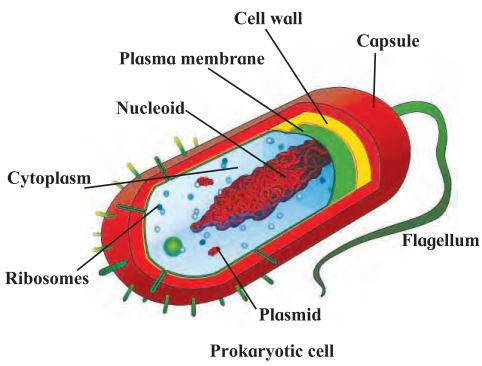
Answer:
- Prokaryotic cell do not have well-defined nucleus.
- The plasma membrane, cytoplasm and nucleoid are the only components.
- The prokaryotic cells have smaller ribosomes compared to eukaryotic cells.
- Bacteria and blue green algae are examples of prokaryotic cell.

Question a.
Draw neat and labelled diagram of plant cell.
Answer:
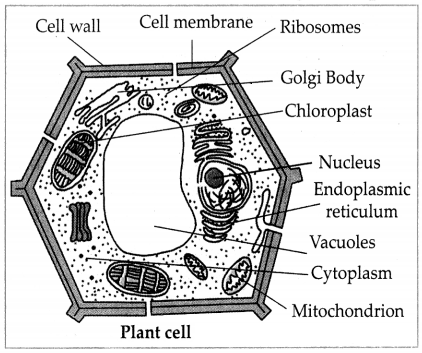
Question b.
Draw neat and labelled diagram of animal cell.
Answer:
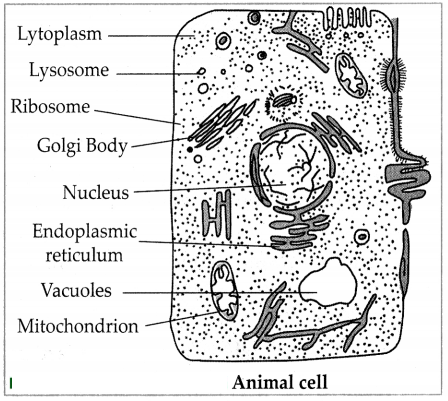
Name the types of cells shown in the diagrams.
Question 1.
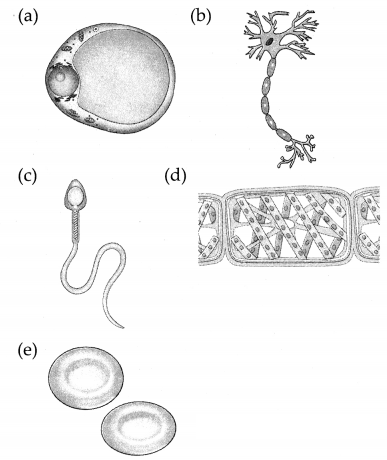
Answer:
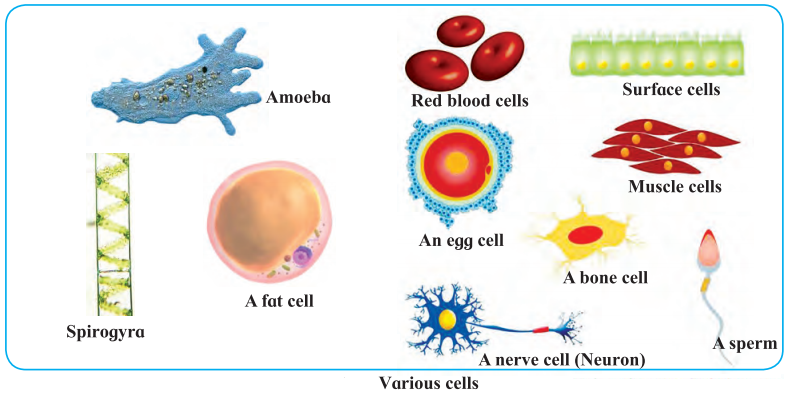
(a) A fat cell
(b) A nerve cell
(c) A sperm cell
(d) Spirogyra
(e) Red Blood cells

Try this:
Answer the following questions:
Question 1.
Keep a moistened piece of bread or bhakari in a closed box. What will you observe after 3-4 days?
Answer:
- I will observe growth of fungus or mucor. White cotton like layer or black spots.
- As we know fungus grows in presence of moisture.
Question 2.
Observe a drop of muddy water or water from a stagnant puddle, under the compound microscope.
Answer:
- We will observe, living things, micro-organism, bacteria, fungi.
- It will be swarming withbacteria,paramoecium, amoeba, ciliated bacteria and protozoa, etc.
Question 3.
Take a drop of yoghurt or buttermilk on a glass slide and observe it under a compound microscope.
Answer:
- I will see Lactobacillus rod shapted bacteria and streptococcus spherical shape bacteria which may be in clusters.
- Lactobacillus use lactose present in the milk and produce lactic acid which gives tangy taste to yoghurt.

Find out:
Answer the following questions:
Question 1.
Which diseases do micro-organism cause in plants and animals?
Answer:
Diseases caused by micro-organism in plants and animals are:
| Plants | Animals |
| Cankers, Downy Mildew, Ergot, Root rot, Rust, Seed Decay, Smut, Soft rot, Wilts, Leaf spot, Crown gel, Curly top, Mosaic leaf, Yellowing of leaf etc. | Anthrax in cattle, Dysentery in monkey, Diphtheria in rabbit, Tuberculosis in cattle, Plaque in rats. |
Question 2.
Why are infants vaccinated according to fixed time schedule?
Answer:
Vaccination is done to protect the child against diseases.
1. If a baby is vaccinated by true vaccine schedule, that baby will have immunity to over 14 diseases by the age of two. With the recommended schedule, babies visit their doctor 5 times in the first 15 months and receive protection against upto 14 diseases in as little as 18 shots.
2. We immunize children so young against these diseases because infancy is the time period that kids are most vulnerable to life threatening diseases.
3. It is not advisable to skip or delay vaccines as this will leave the child vulnerable to disease for a longer period of time.
Can you tell?
Answer the following questions:
Question 1.
Observe cells from various parts of plants like leaves, bark, root tips, etc.
Answer:
Question a.
Are the cells that you observed, all alike?
Answer:
No, all cells do not look alike, each one has different shape and size.

Question b.
What are their shapes?
Answer:
- The cells of leaves, show a green pigment because of chloroplast.
- The shape of the cell may be spherical or polygonal.
- The shape of root tips are oval or polygonal and the cells of back are hexagonal in shape.
Question 2.
Observe the roots of the pea, bean and fenugreek plants. What could be the functions of the nodules on their roots.
Answer:
- Micro-organisms are present in the root nodules.
- They fix the atmospheric nitrogen and make it available for plants.
Question 3.
What happens if clothes remain damp in the rainy season?
Answer:
- During rainy season the humidity in the air is quite high and also.
- Due to presence of moisture in clothes it becomes breeding ground for fungus.
- It is the favourable condition for growth of fungus.
- We can see white cotton like growth of fungus on clothes.

Question 4.
What are the black or white spots sometimes seen on gunny bags?
Answer:
These spots are the growth of many microbes such as fungi, mucus, mold, etc.
Question 5.
Why are leather articles like purses, wallets, belts, footwear always polished before storing away?
Answer:
They are polished so as to protect them from the growth of fungus.
- Polish creates a layer of wax on them so that moisture cannot enter from atmosphere.
- It prevents the growth of fungus, which damages the leather.
Question 6.
What is the powdery material found on old currency notes or old rubber or paper?
Answer:
- The powdery material is the spores of fungi.
- All the materials like gunny bags, cotton clothes, paper, rubber, etc. are plant products and leather is an animal product.
- In a humid atmosphere, fungi and some other micro-organisms grow on these articles and spoil or damage them.
Question 7.
Why children are vaccinated?
Answer:
- A vaccine is produced in a laboratory with the help of microbes, that gives immunity against particular diseases.
- Vaccine is actually a live micro-organism which is weak.
- When injected into a person in small amount, antibodies are produced.
- It increases the resistance power against the disease produced by that micro-organism. So, the possibility of contracting that disease is greatly reduced.

Question 8.
Try this and answer the following questions:
| In pot A | In pot B |
| Soil + garden waste + dung + fruit peel vegetable stalks | Pieces of glass + scrap metal + plastic bags + Soil. |
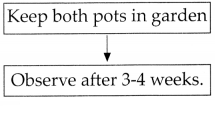
Question a.
Did the garbage in pot B remain unchanged.
Answer:
- Yes, the garbage in pot B remained unchanged because micro-organisms need nutrients for their growth.
- In pot B there was no medium for growth of micro-organisms.
Question b.
Where did the garbage in pot ‘A’ disappear? Why?
Answer:
- Microbes present in soil, dung, etc. decompose the garbage to obtain food material.
- As a result garbage is soon converted into manure of the best quality and our surroundings are kept clean.

Question 9.
What does your mother do to make yoghurt from milk?
Answer:
- Few drops of yoghurt or buttermilk are mixed with lukewarm milk and it is kept at room temperature for 8-10 hours.
- Microbes present in the drops of yoghurt quickly multiply and the milk gets converted into yoghurt. This is a process of fermentation.
Question 10.
Who discovered the process of fermentation?
Answer:
- Louis Pasteur established that fermentation is initiated by living organisms.
- It involves yeast microbes, breaking down molecules of complex carbohydrates into simple sugar, alcohol and CO 2 .
Use your brain power!
Answer the following questions:
Question 1.
How will you know that a foodstuff is spoilt?
Answer:
- When the food is kept for a long time it allows the growth of bacteria and fungi.
- We can see the white layer of bacterial or fungal growth on it, it causes a typical odour, or smell, and also the food tastes sour due to presence of enterotoxins produced by fungi in the food.

Question 2.
What precautions will you take while purchasing food? Why?
Answer:
- We will see the expiry date. If the food is kept for a long period of time, it may allow the growth of many microbes which can cause disease or food poisoning.
- We will check for any fungal growth, any white or black spots on it.
Question 3.
Why do food poisoning incidents occur during marriage or other community feasts?
Answer:
1. During marriage feast, food is prepared in very large quantity and food may not be properly washed or if it is cooked with water contaminated, with sewage or dirt which has many disease causing microbes, or the people handling the food may be having dirty hands
2. Also the utensils used for cooking and storing food may be dirty, contaminated with dirt and may produce microbes. The consumption of such food is responsible for food poisoning.
Question 4.
How do the cells acquire definite shapes?
Answer:
The cells acquire definite shapes due to the presence of cell wall.
Question 5.
How are cells protected?
Answer:
- Plant cells are protected due to presence of cell wall.
- Animal cells are protected by the double plasma membrane.

Question 6.
What are the needs of cells?
Answer:
- The most important things for a cell are oxygen and glucose.
- Cell uses these during process of glycolysis and makes ATP which is energy source.
Question 7.
Can the point of a needle accommodate micro-organism?
Answer:
Yes, they are smaller than the point of a needle.
Question 8.
Why should dry and wet waste be collected separately?
Answer:
- Dry waste consist of plastic, glass, metals, paper, etc. It is easier to segregate dry waste so that it is easier for treatment and recycling of waste.
- Wet waste consists of organic matter. Wet garbage is converted into manure of the best quality and surroundings are kept clean.
Question 9.
Why is yoghurt mixed in the batter or dough for making rava-idli, butter naan?
Answer:
- The microbes present in yoghurt are allowed to grow in batter or dough.
- They break down these substances producing new compound and gases are released as they grow and multiply in them which allows the batter, dough to rise.
- This process is called fermentation.
- This makes the food soft and nutritious.

Question 10.
How do preparation like yoghurt, idli, dosa become easy to digest?
Answer:
Fermentation does detoxification and splits complex carbohydrates and proteins into simple ones. Thus, making it easy to digest.
Question 11.
What is the co-relation between the normal body temperature of humans which is 37°C and the optimum temperature for the growth of micro-organism, 15 °C to 35 °C?
Answer:
- Each micro-organism needs a specific environment for growth and reproduction.
- Optimum temperature for the growth of micro-organism is 15°C to 35°C.
- Normal body temperature of human body is 37°C. At that temperature micro-organism can not grow and cause disease.
Question 12.
How do micro-organism survive the adverse conditions?
Answer:
- During adverse conditions micro-organisms form a thick covering around themselves and stop their life processes.
- On return of favourable conditions they come out of the protective covering and continue their life processes.
